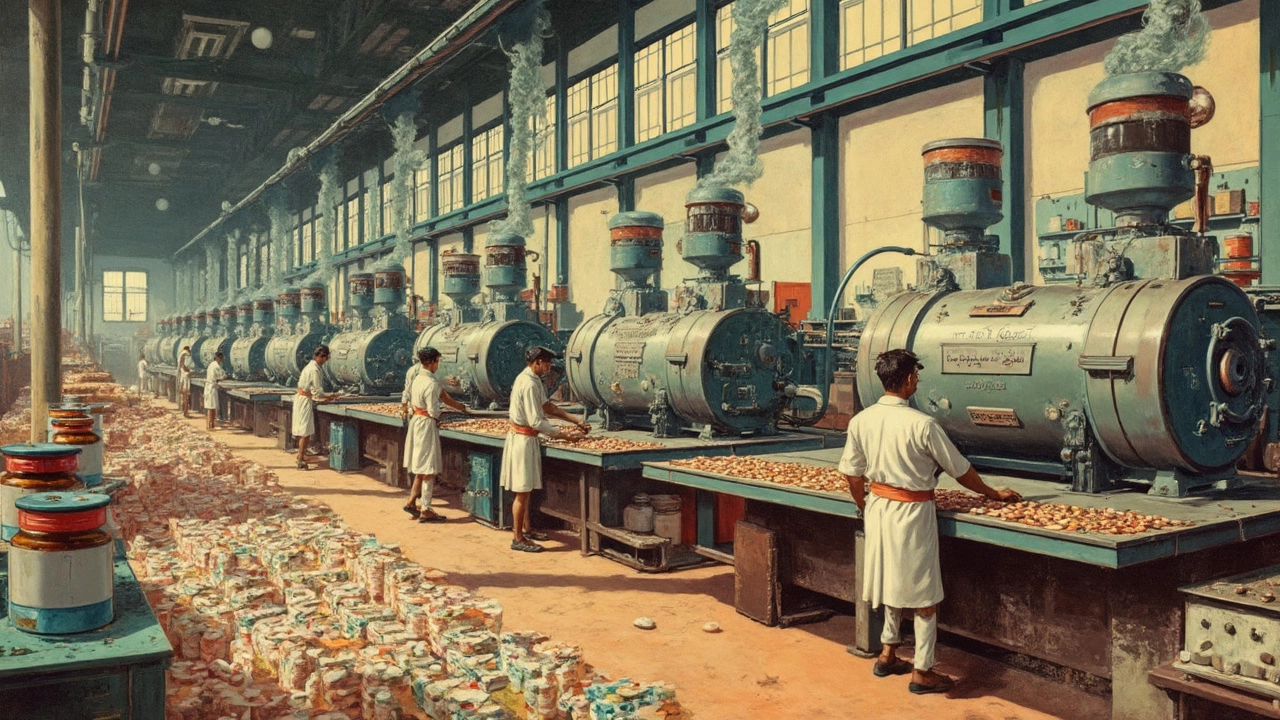
India's pharmaceutical industry is vast, but have you ever thought about where it all began? Rewind to the late 19th century and you'll find the roots in Bengal Chemicals, the first of its kind in India. Founded by the visionary scientist Acharya Prafulla Chandra Ray in 1892, Bengal Chemicals set the stage for India's pharmaceutical revolution.
It's pretty fascinating. Imagine the time when India was still under British rule, and an Indian scientist dared to dream of self-reliance in healthcare. Ray's mission was not just about making medicines; it was about scientific research and indigenous production. The company became a symbol of innovation mixed with national pride.
Intrigued by the industry's evolution? As Bengal Chemicals grew, it had to constantly innovate to keep up with the changing times. From creating products for common ailments to stepping into the antiseptic and hygiene segments, they've done it all. But what’s even more notable is their adaptability through the decades.
- Bengal Chemicals: The Pioneering Journey
- Heritage and Evolution Over Decades
- Innovations and Key Milestones
- Challenges and Resilience
- Legacy and Impact on Modern Pharma
Bengal Chemicals: The Pioneering Journey
The journey of Bengal Chemicals is like a thrilling chapter in India's industrial history. It all started in 1892 when Acharya Prafulla Chandra Ray, a chemistry genius, laid the foundation. Imagine a time when India was heavily dependent on foreign goods, and here was Ray, challenging the norm with a bold vision of making India self-sufficient in pharmaceuticals.
The company began its operations in Kolkata (formerly Calcutta), initially focusing on small-scale production. By manufacturing medicines for essential healthcare, it became a beacon of hope for many. The company's establishment marked a significant shift toward indigenous pharmaceutical manufacturing.
Early Challenges and Achievements
Let's not forget the hurdles that India's oldest pharma company faced. The late 19th and early 20th centuries were arduous, competing with established global players wasn't easy. Yet, Bengal Chemicals persisted, innovating tirelessly and setting up modern production plants to improve efficiency and reach.
Expansion and Growth
By the 1920s, Bengal Chemicals began diversifying its product line. They started producing not just medicines but also items related to hygiene and antiseptics. This diversification helped the company widen its reach, making its products household names.
They weren't just about products; Bengal Chemicals was also a hub for nurturing talent. Many of India's first generation of chemists and pharmacists trained here, spreading the know-how across the nation.
Recognition and Legacy
Bengal Chemicals played a pivotal role in India's freedom movement by proving that Indian industries could match their foreign counterparts. It was a statement of self-reliance long before ‘Make in India’ became a buzzword.
Today, the legacy of Bengal Chemicals continues, reminding us of a time when daring ideas and hard work paved the way for a vibrant pharmaceutical industry in India. It’s a journey of courage, innovation, and profound impact.
Heritage and Evolution Over Decades
Bengal Chemicals & Pharmaceuticals Ltd. isn’t just the oldest pharma company in India; it's a living example of persistence and adaptability. From its humble beginnings in Kolkata in the late 1800s, the company saw early success by manufacturing simple yet essential products like eucalyptus oil and glycerine.
By the time India approached independence, Bengal Chemicals had already established itself as a formidable player. The company expanded its production line to include more complex pharmaceuticals and even ventured into making household products like soaps and detergents.
Riding the Waves of Change
The post-independence era came with its set of challenges. Increased competition and the entry of foreign pharmaceutical giants pushed Bengal Chemicals to rethink its strategies. Instead of trying to beat them at their own game, they honed their reputation as a reliable local manufacturer, focusing on affordability and accessibility for the average Indian.
Sustaining Innovation
As the pharmaceutical industry boomed in the 1970s and 80s, Bengal Chemicals diversified further. The company began to produce life-saving drugs, keeping up with the latest advancements in healthcare. These decades marked a significant phase of ramping up R&D efforts to ensure that they stayed relevant.
During challenging times, they didn't shy away from collaborations and partnerships either. Through strategic alliances, they strengthened their foothold in both local and international markets.
Numbers That Tell a Story
A glance at their trajectory offers valuable insights into their evolving business model:
| Decade | Key Developments |
|---|---|
| 1890s | Establishment and foundational products |
| 1940s | Expansion into diverse goods |
| 1970s | Increased focus on R&D, life-saving drugs |
| 2000s | Collaborations and global outreach |
Despite facing periods of financial constraints, Bengal Chemicals remained committed to its legacy of quality and trust. Today, it stands as a testament to the innovative spirit and resilience that typifies the journey of Indian pharmaceutical companies through the decades.

Innovations and Key Milestones
When we talk about Bengal Chemicals, we're talking about a company that's not only about history but also about breakthroughs. One of their standout innovations was the manufacturing of the first indigenous pills and drugs in India, something unprecedented back then.
Founded by Acharya Prafulla Chandra Ray, this oldest pharma company in India set several benchmarks. Ray was a visionary who believed in using natural resources efficiently. In 1893, Bengal Chemicals became a pioneer by introducing quinine to combat malaria, a disease rampant at the time. This not only brought relief to many but also put India on the map for pharmaceutical capabilities.
"Bengal Chemicals represents the spirit of innovation and resilience in India's pharmaceutical journey." - Indian Pharmacist Association
Another breakthrough was the production of phenyl, an effective disinfectant that came when hygiene was becoming critically important. Bengal Chemicals not only created products but also educated people about their uses, intertwining innovation with education.
Notable Product Launches
- The Strychnine pill (1905): Used as a stimulant, it was one of their first pharmaceutical products.
- Anti-malarial Quinine (1893): A pivotal product in India’s health landscape.
- Bengal Phenyle (1920s): Marked the company’s expansion into hygiene and disinfectants.
The path wasn't always smooth. The company faced many external and internal challenges over the decades. Yet, their drive for excellence remained unshaken. They continually adapted, delved into research, and evolved with modern practices, ensuring they weren't left behind.
Innovation doesn't just stop with product development. Bengal Chemicals also focused on collaborations with research institutions to drive better healthcare solutions. The establishment has continuously supported scientific endeavors, contributing significantly to India's pharmaceutical history.
Challenges and Resilience
Running a pharma company isn't all sunshine and rainbows, especially when you're the oldest in the business like Bengal Chemicals. They've hit rocky roads over the years, from heavy competition to financial bumps that could have easily derailed the entire operation.
Facing Financial Strains
Bengal Chemicals weathered significant financial challenges, especially around the mid-20th century. Post-independence, as more pharma manufacturers in India emerged, Bengal Chemicals faced increased competition. Moreover, limited funds often hampered their ability to expand and innovate.Navigating a Competitive Market
The entry of global giants into India's pharmaceutical scene only added more pressure. To stay afloat, Bengal Chemicals had to continuously distinguish itself through quality and local expertise. They focused on leveraging their historical legacy while ensuring their products adhered to modern standards.Adapting to Change
Regulatory changes over the years meant constant adaptations. While many companies struggled with compliance, Bengal Chemicals focused on strengthening their R&D, ensuring they met every new standard head-on.During the tougher times, resilience came in the form of lean operations. By smartly managing resources and minimizing unnecessary expenses, Bengal Chemicals always found a way to push through.
Learning from the Past
If there's one lesson from their story, it's never backing down. Learning from past mistakes and continually improving processes kept this oldest pharma company thriving even when the odds seemed tough.
Their struggles and triumphs offer a blueprint for newer pharma manufacturers in India today. History might have thrown curveballs their way, but Bengal Chemicals remains a testament to determination, adaptation, and growth.

Legacy and Impact on Modern Pharma
Bengal Chemicals' journey is more than just a tale from the past – it's a crucial part of India's pharmaceutical story today. By being the nation's oldest pharma company, they’ve paved the way for the modern industry, influencing countless manufacturers that followed.
The company showcased how indigenous production could hold its own against established foreign players. They emphasized local research and development, showing others that Indian companies could innovate and produce quality products at competitive prices. This became the backbone of India’s competitive advantage in the pharmaceutical history.
Setting Standards for Quality and Innovation
Even from its early days, Bengal Chemicals focused on high standards of production. This commitment to quality set a benchmark that many modern pharma companies emulate today. Back when global certifications weren’t a norm, they were pushing boundaries in quality control, a practice that is vital in today's pharma industry.
Influence on Today’s Market Leaders
The influence of Bengal Chemicals goes beyond past achievements. Contemporary companies have followed their footsteps in blending traditional practices with modern science. Top Indian pharmaceutical firms have adopted this approach, thriving in both local and international markets. Their competitive pricing strategy, inspired partly by Bengal Chemicals, has made India a major player globally.
Statistical Snapshot
Here’s a quick look at some figures that highlight the impact:
| Aspect | Bengal Chemicals | Modern Pharma Industry |
|---|---|---|
| Start Year | 1892 | Multiple in post-1947 era |
| Focus | Research and Indigenous Production | Quality & Global Distribution |
| Expansion | Nationwide | Global |
In essence, Bengal Chemicals didn’t just aim for immediate success but laid a foundation that supports today’s robust pharmaceutical landscape. They proved that with determination and innovation, Indian pharma manufacturers could not only survive but thrive.